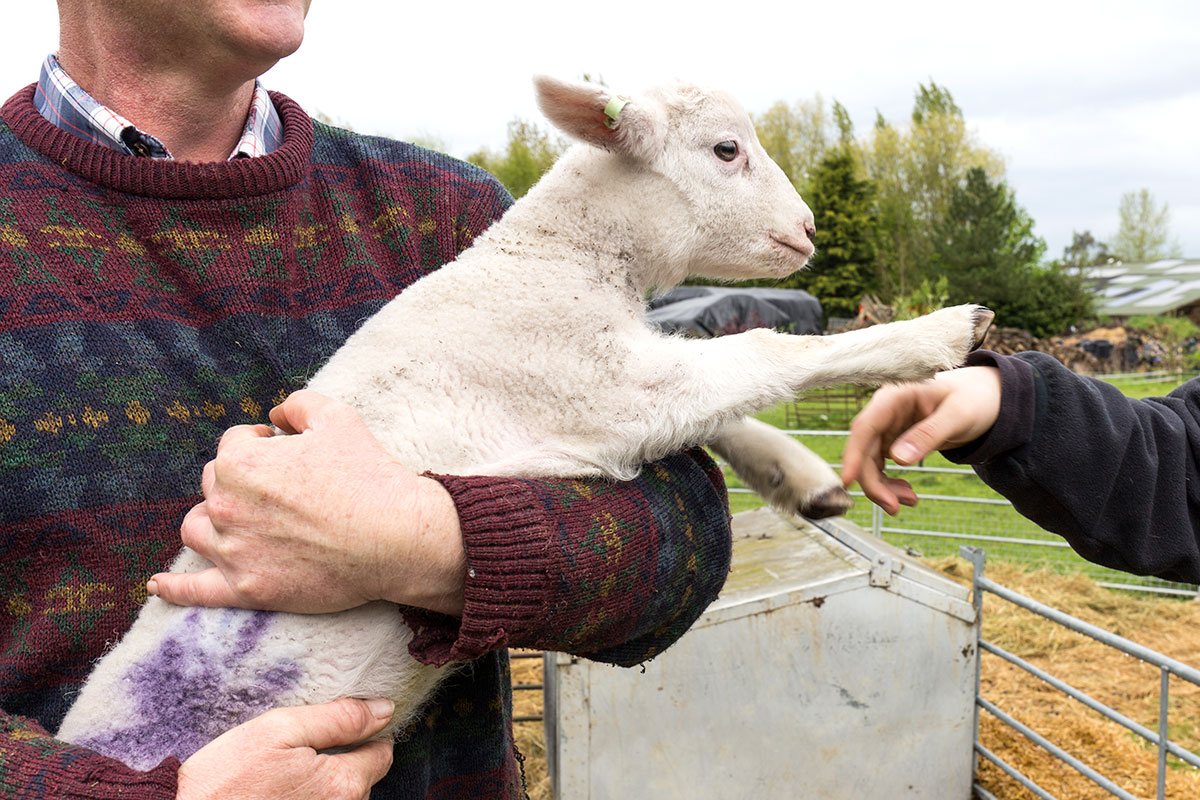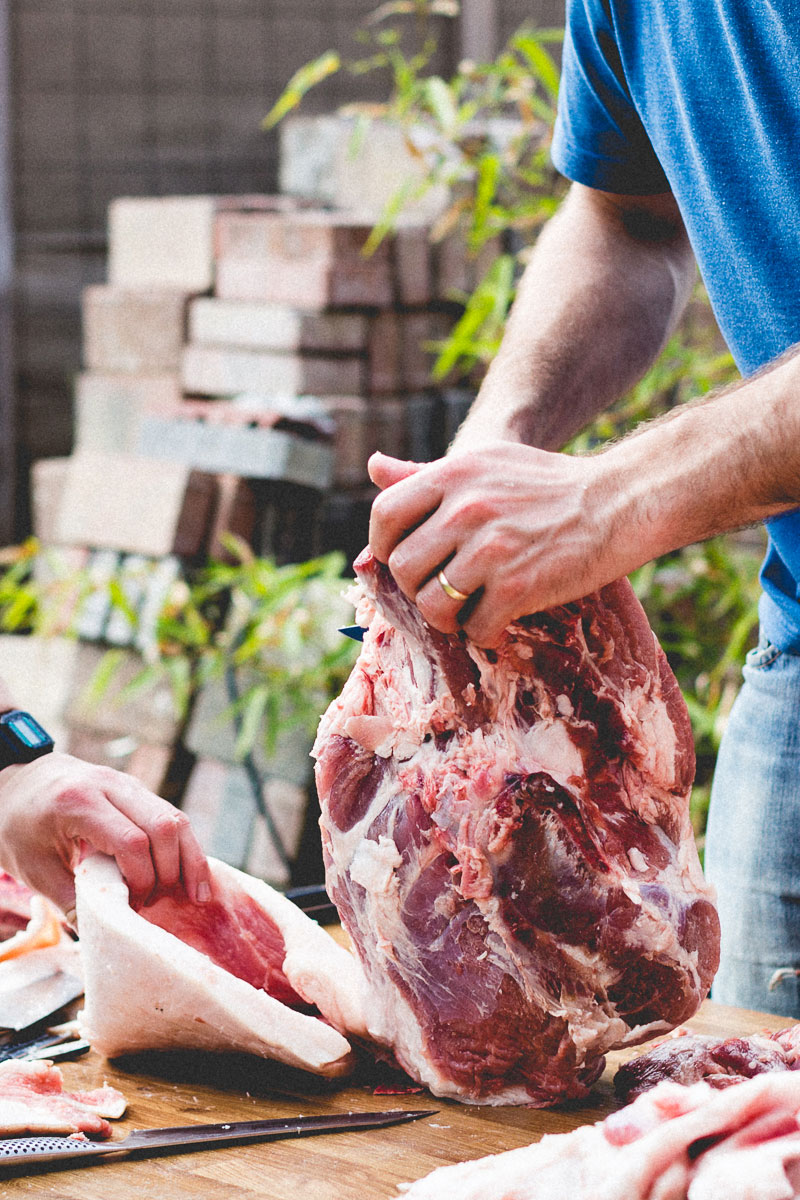Continued from Part 4: ‘Reactionary Veganism’

Back in the kitchen, Tomáš was preparing the head, deciding to split it, to rescue the tongue intact. Gruesomely, we used a wood saw to cut through the skull and separate Theresa’s head into two halves. This sounds disturbing, however, like many seemingly gruesome events in life, the reality is far easier to handle than the anticipation of it.
For example, would you enjoy watching a video of a human having surgery? Unlikely, I guess. Would you appreciate having surgery performed upon you to resolve an illness? Most probably. Would you watch videos of animals being killed? Unlikely as well.
Certain activities are not performed for any kind of voyeuristic performance, but for the health of humankind and I’d suggest that the butchering of animals is one of those things. Just like surgery or slaughter, this is not a spectator sport.
Watching a YouTube video on butchery techniques in preparation made my skin curl and my stomach twist. On the day, my initial reaction of disgust at the proliferation of flesh, skin, internal organs and blood gave way as soon as my hands were handling flesh and covered in pig fat. Any resistance quickly attenuated to this process and no matter which part of the body I worked with, be it brain, ear, foot, tail or stomach, it was all meat and held with equal esteem.
Virtually every part of the animal was used, bar a bag of fat, bones and a few other inedible parts that were discarded. Upon leaving, my bags were packed with pate, raw meat, homemade sausages, offal, crackling, lard and more, plus a huge slab of belly to cure as bacon. Preparing and cooking this pig was a spectacular amount of work which demonstrates why whole villages would only slaughter animals on special occasions, butchering an animal is an event which requires dedication, skill, knowledge and piles of labour. No-one one would go through this process for a quick mid-week supper.
Not one element of the day, or the work, felt inherently wrong. Never did my intuition sting or feel like a bad thing. This felt like life, like natural, human living.

The mockumentary ‘Carnage’ by Simon Amstell foretells a future, fifty years from now, where eating meat becomes culturally outrageous, leading older members of society into recovery support groups to process the historic pain they inflicted upon animals. Leonardo da Vinci famously insisted that we have no God-given right to eat our fellow creatures and I previously considered such ideas as inevitable, yet now, I disagree.
Killing animals is surely sad, there’s no denying that. Yet, it’s important to remember that in life, sad does not equal bad. We experience many events in our life which are extremely sad, usually involving the separation of ourselves from someone that we love and care for, be it moving away, adoption, death or simply ending a relationship. Avoiding situations in life simply because they are sad, or blocking the sadness out, is unhealthy.
Death is intrinsic to life, just as birth, both are inevitabilities to be handled with dignity, love and respect, even celebration.
Respect is the element which remains in stark absence from modern meat consumption. When did you last feel a sense of sadness or respect purchasing sausages at the supermarket? Our contemporary sources of meat allow society to become completely emotionally detached from the entire process that brings it to the plate.
The medical world is dedicated to defending the health of mankind, yet it’s a world which, behind the scenes, would turn the most hardened of stomachs. We have little problem with sedating people to reduce their ability to feel pain, before performing gruesome procedures to enhance their health. Preparing animals is similar, they are stunned and then killed, before being subject to these gruesome preparations which provide health-giving properties to us. The key difference is that medicine aims to preserve life, while animal slaughter ends it, but they are both gruesome worlds, it would be unfair to reject meat on the grounds of any squeamishness.
There is no denying that meat can be beneficial for our health and the environment, when consumed in small amounts from a good source. Killing animals is a cornerstone of human evolution, eating the flesh of animals facilitated our evolution to this current physiologically advanced state. The historic population growth of the world is partially based upon eating meat, due to the enhanced nutritional value and sustenance it provided. It’s ironic that the decision to not eat meat is only possible due to our advanced evolutionary pathway predicated upon that very conusmption of meat.
Of course, the one thing which animals lack is agency, they have no choice in their fate, but we do, and that is the moral sticking point.
If we assume that animals have equal rights to humans, then we have no right to kill them.
However, as any cat owner will know, carnivorous animals have a playful thirst for the life of other animals and when it comes to sport or hunger, they will happily kill each other. These creatures are not working on the same introspective, intellectual and philosophical level that we are, perhaps they didn’t get the memo. However, an animal’s inherent desire to hunt is not a reason for us to do the same to them, because we have the capacity to make ethical choices.

Humankind began killing animals during a simpler, less developed period, when we were innately connected to the land we lived upon, which speaks volumes about the intuitive human ability to eat the food that truly nourishes us. It’s a different place from the modern, urban, intellectualised meanderings that justify cessation of meat consumption. 88% of vegans live in urban, or suburban areas, meaning those who live in the countryside, spending their lives tending to the earth and animals which provide food, are predominantly omnivores.
Those who are completely removed from the life of agricultural production and animal husbandry by the urban sprawl are the ones predominantly removing meat from their diet.
The theme of disconnection appears yet again, riding the burgeoning wave of veganism, a lifestyle rather than a diet, which espouses a good/bad dichotomy of extreme positions when it comes to meat.
However, a good diet, like a good food system, is a place of diversity and any form of absolutism often brings it’s own problems…
Continued in Part 6: Eat Whatever the Hell You Want

